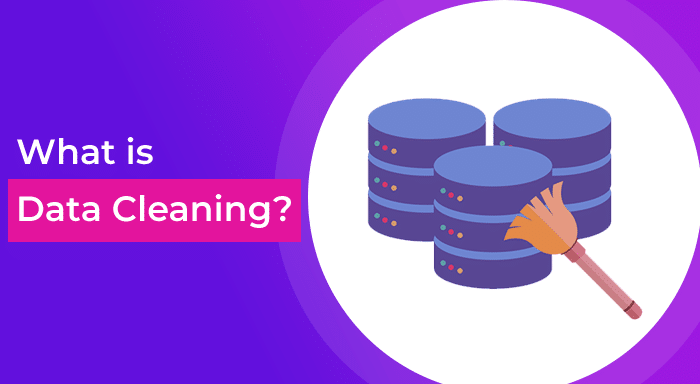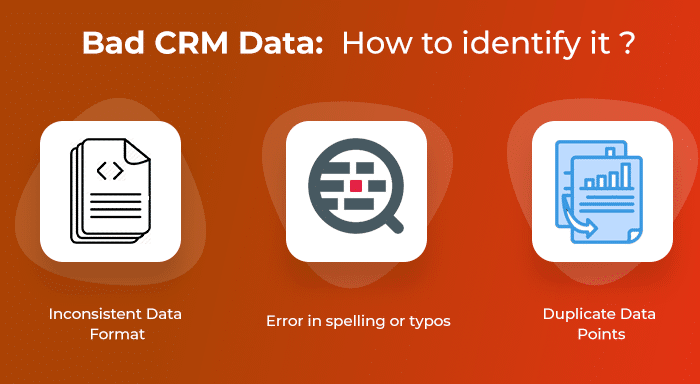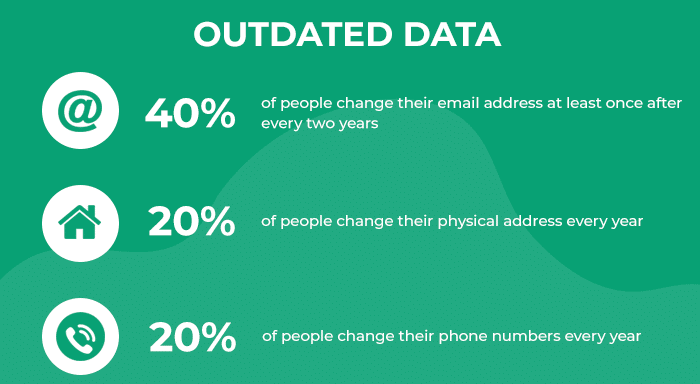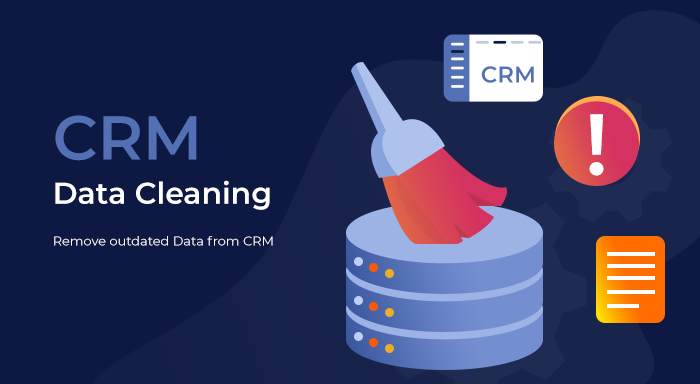Data can be useful for any business there is certainly no doubt about that. But things can go sideways quickly if this same data becomes uncontrolled and takes the shape of irrelevant yet ever-growing information. Understand this issue with an example, suppose you have a gigantic pile of contact information, but most of this data contains invalid email IDs, and duplicate, and incomplete contact data. Another problem with having these data silos is you can’t use this raw and irrelevant data in any automated process like machine learning. The only way to save this shape is to perform CRM data cleaning (aka data cleansing) on a regular basis.
Now you must be wondering why CRM (Customer Relationship Management) software only and the answer lies in the application of this software. Most companies use CRM for managing customer data and therefore it acts as the storage unit of the entire system. A report suggests that almost 30% of company data becomes outdated after one year. Therefore, every business should learn the perfect way of cleansing their CRM software. In this article, we will share every detail that you need to know about data cleaning of CRM.
“A CRM system can operate on the optimum level only if it is kept tidy and clean thoroughly.”
What is Data Cleaning?
In generic terms, data cleaning or data cleansing is the process of removing data that is mostly outdated, inaccurate, corrupted, and non-credible from the system. However, when it comes to CRM software the process became a bit more complicated because here we are specifically talking about the sales and marketing data of an organization.

For example, a sales team may encounter a lot of problems because the data cleaning process is not done in the way it should be. In order to grab more opportunities and leads, reps need to have access to up-to-date and credible data all the time. The slightest mistake in the cleansing process can lead to catastrophic failure in the entire sales process and even collapse the system as a whole, which highlights what makes manually cleaning data challenging for teams that rely heavily on CRM systems..
There are other effects as well like inefficient and longer sales cycles, sales funnels will not be performing well too. The outdated information could lead you to unworthy prospects, which means, you’ll be spending time on nurturing leads that are never meant to be customers and miss the real opportunities. All these drawbacks can be avoided by simply adopting three steps i.e. (i) identification of corrupt/outdated data (ii) Removal of unnecessary information (iii) Updating the current data to the latest.
“Big data is at the foundation of all of the megatrends that are happening today, from social to mobile to the cloud to gaming.” This quote is more than enough to tell you the importance of data and technologies related to it like machine learning, Artificial Intelligence, Big Data, and IoT (Internet of Things).
What is Bad CRM Data and How to Identify it?
As we mentioned earlier almost 30% of CRM went irrelevant or outdated almost after a year. But what does bad CRM data look like and how can you identify it? In this section, we are going to unravel this. If this data piled on for a long period of time then it could start the domino effect and eventually start affecting the other business decisions as well like marketing campaigns, sales strategy, etc.

Here we are going to enlist different types of bad data that can ruin your CRM system to a great extent. There are some usual activities as well that can lead to bad CRM data if not performed in the right way, let’s have a look at them one by one.
1.Outdated Data
- With every second passed, data is becoming more and more outdated. For example, people usually change their phone number, email address, physical address, and job roles very frequently. So you have to keep in mind that data in your CRM should be as fresh as it possibly can be. Here are some statistics that can back the statement we just made.

- Email Address: 40% of people change their email address at least once after every two years. It means if you fail to update this information then you are highly likely to lose a nurtured customer.
- Physical Address: However this rate is lower but still 20% of people change their physical address every year.
- Phone Numbers: Phones are a very important way of communication between a customer and a company, therefore, it becomes crucial to keep this piece of information up-to-date. This job becomes more difficult because 18% of people change their phone numbers every year.
2. Inconsistent Data Format
If your company has not adopted any SOP software (Standard Operating Procedure) for data entry of different figures such as email addresses, phone numbers, names, etc then there can be issues in format. The reason behind this is every person has their own way of inputting data, which could lead to inconsistent data format. But the good thing is that you can fix this issue easily by introducing automated tools like Unique ID Generator in your CRM. This will create consistent and uniform unique IDs for long lists of CRM data.
3. Error in spelling or typos
This mistake is committed by the customers as well as company employees. For example, if a customer visits your website and in the online form he fills out the wrong information. It will automatically save to the database, regardless of its correctness. The same scenario is plausible when an employee performs typos, which is pretty common in manual data entry.
4. Duplicate Data Points
This mostly happens when migrating data from one CRM database to another or merging two different lists. This could create confusion within the sales and marketing departments.
Essential Steps to Perform CRM Data Cleansing
Now you know what causes mistakes and errors in your CRM database, it’s time to learn how we can fix them. Based on the causes and different situations there are different types of CRM data cleaning processes.
1. Data Audit
The data audit step involves thoroughly examining the current state of your CRM data. It includes assessing the quality, accuracy, inconsistencies, duplicates, and completeness of the data. During the audit, you'll identify any inconsistencies, duplicates, or missing information in your CRM system. This step helps you gain a clear understanding of the quality of your data and serves as a baseline for the data cleansing process. It's essential to understand the current state of your data before proceeding with the cleansing process.
2. Define Data Quality Standards
Establishing data quality standards is crucial to ensure consistent and accurate data. Determine the specific criteria for clean data, such as valid email addresses, complete contact information, and standardized formats. This step helps create a benchmark against which you can measure the success of your data cleansing efforts. Defining data quality standards is crucial for maintaining consistent and accurate CRM data. Data quality standards establish specific criteria that your data must meet to be considered clean and reliable. These standards can include guidelines for valid email addresses, complete contact information, standardized formats, consistent naming conventions, and other relevant factors. By setting clear standards, you can measure and enforce data quality throughout your CRM system.
3. Fix Formatting Issues
Format issues could be information in wrong fields, names with letters that are not capitalized, abbreviations of states, countries, counties, etc are not used properly. Apart from that use of a standard format for all manual data entry processes should become mandatory. This will allow the sales and marketing representatives to find the appropriate information in no time.
4. Use Standard and Consistent Terminologies
You also need to make sure that most of the fields use a standard format and terminologies. For example, if you are describing a position as “Sales Person” then you do not use any other like a salesman or sales representative whatsoever. If you do so then it can create confusion and your CRM will seem messy. This is one of the most common mistakes companies make. In order to get an idea you can look at the industry standards and according to them, you can assign consistent nomenclature to your CRM software.
5. Get rid of recurring fields
This happens when merging two or more records. In this, there are chances that more than one field for the same purpose exists in the new record. Therefore, you should audit the newly created record after merging them and also have a keen eye for values that are not placed on the right fields.
6. Delete Unnecessary and Irrelevant information
If you haven’t performed CRM Data cleaning for years then you might end up with information in your database that has no meaning to you whatsoever. If that’s the case with you as well then you should not be afraid of deleting such records. This bad data is only tampering with the quality of the CRM database. For longer, if you keep this information you are jeopardizing the integrity of your database management system.
7. Correct Inaccurate or Incomplete Data
Analyze your CRM data for incomplete or erroneous entries. Address missing or incorrect information by leveraging various data sources or third-party services. Using tools like an email reverse lookup service can help ensure that CRM entries are accurate and current, improving the reliability of customer data in your system. For instance, you can use address verification services to validate postal addresses, email validation tools to check the accuracy of email addresses, or phone number lookup services to validate and update phone numbers. You can also leverage various data sources or third-party services. For instance, you can use data validation tools to verify and correct email addresses and phone number lookup services to update phone numbers.
8. Limit the number of people who enters the data
This is the best thing you can ever do in order to minimize clerical flaws and other kinds of data entry mistakes. If the number of hands involved in database management is limited and those who are involved know their work, everything will be right. You can do this by limiting the privileges to the team members and this makes sense because everyone should not have administrative authority over the database. You can also hide sensitive and editable fields from those users who don’t require access to them.
9. Implement Data Governance
Data governance refers to the establishment of policies, procedures, and guidelines to ensure the ongoing quality and integrity of your CRM data. You need to set up data governance policies and procedures to maintain ongoing data quality and integrity at all times. Define roles and responsibilities for data management, including data entry, data validation, and data maintenance. Regularly monitor and enforce these policies to maintain the cleanliness of your CRM data. Data governance helps ensure that data-related activities are properly organized, monitored, and controlled, leading to improved data quality and consistency.
10. Regular Maintenance
Regular maintenance is an essential component of effective CRM data cleansing. It involves implementing routine practices to keep your CRM data accurate and up to date. This can include performing periodic data audits to identify any new data quality issues, validating and updating data on a regular basis, deduplicating records to eliminate duplicates, and continuously monitoring the quality of your CRM data. Regular maintenance ensures that your CRM system remains clean and reliable over time.
The Final Words
Now, you know how bad data can affect the operation of your company it is important to fix them as soon as possible. CRM Data cleaning is the best way to do so. After cleansing the database, you also have to make sure to maintain its optimum form as long as possible. For this, you can set some standardized procedures
Author’s BIO

With 15 years of experience in CRM, I specialize in developing plugins for SuiteCRM and SugarCRM. My notable creations include SuiteCRM Email to Lead, SuiteCRM BCC Archiver, and SugarCRM Mailchimp. My expertise lies in enhancing CRM functionalities to drive business efficiency and growth.
Additionally, I create content on YouTube, sharing insights and tutorials on CRM solutions to help businesses enhance their efficiency and growth.



